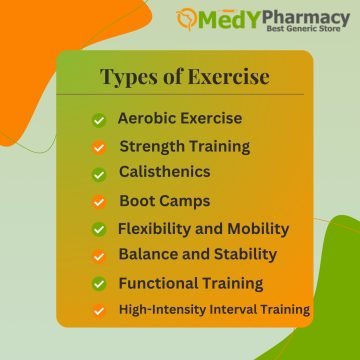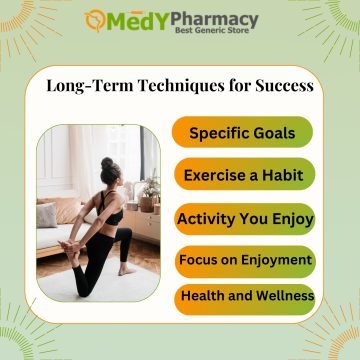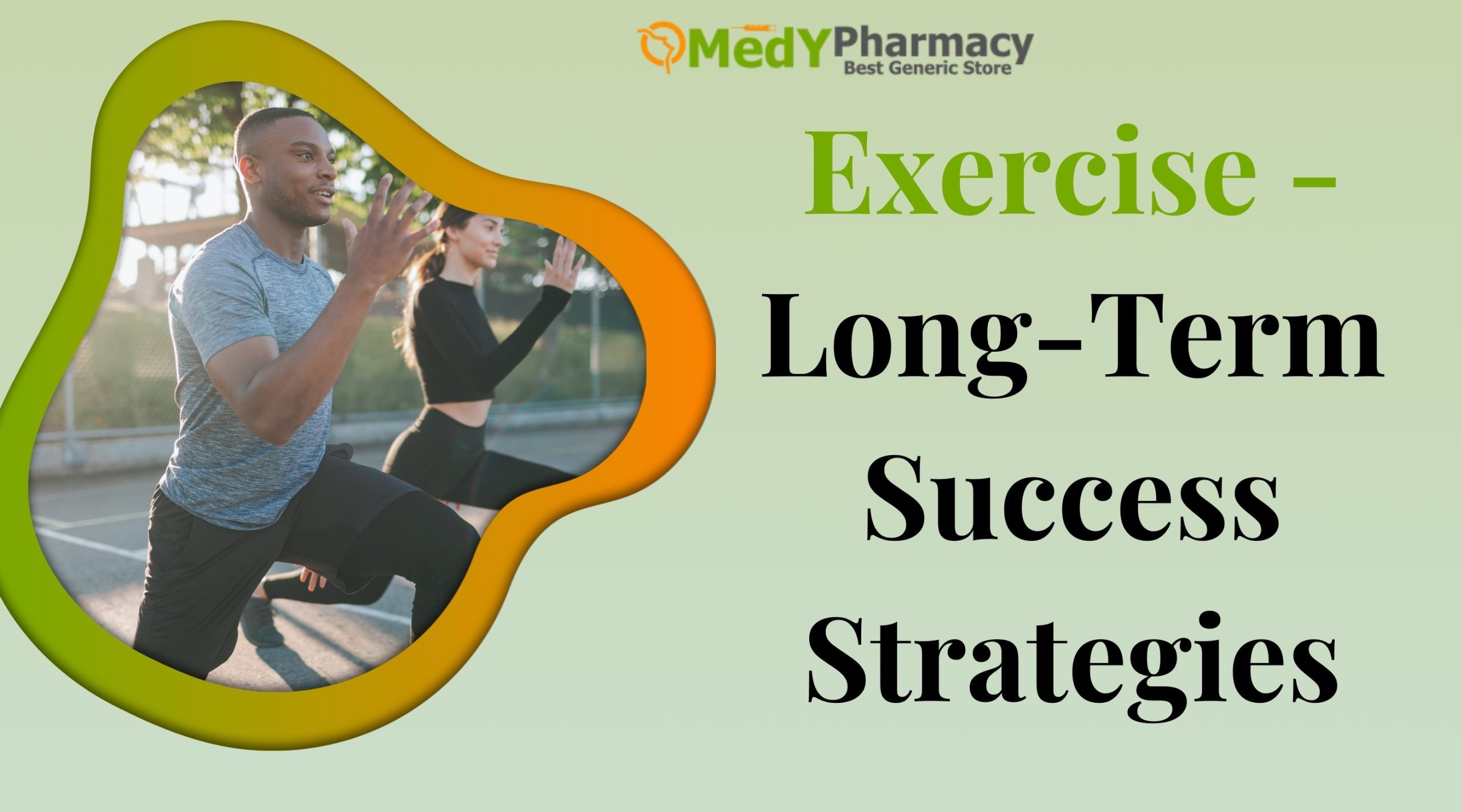Introduction:
You are aware that exercise has several health advantages. However, due to hectic work and family schedules, as well as inexperience, you might not know where or how to start.
Think about this before you neglect to include exercise on your list of priorities: this may be just as effective as medicine for a variety of ailments. This has benefits comparable to those of anti-inflammatory medications, insulin, anxiety medications, and weight reduction supplements, according to studies. It’s worthwhile to begin exercising even if you already have diabetes or heart disease since it can have a significant impact on your health.
In the short term, exercise can help control your hormones and blood pressure levels, as well as enhance your mood, mental health, and sleep quality.
This has several long-term advantages, including lowering your chance of developing chronic illnesses and helping you reach and maintain a healthy body weight and muscle mass.
If you are thinking of beginning an exercise regimen but are unsure of where to start, this article is for you. This is all the information you require to establish and maintain a routine.
As you are undoubtedly aware, exercise has several positive effects on mood, energy, sleep, and health, as well as lowering stress, anxiety, and depression. And it only takes a click to access comprehensive training regimens and exercise instructions. We’d all be in shape, though, if understanding how and why to exercise was sufficient. It takes more to make exercise a habit; you need to have the correct attitude and a calculated strategy.
What Is Exercise?
This is essential to living a healthy lifestyle. However, starting an exercise regimen may seem unattainable if you have lost the habit of being active or have never discovered a successful one.
Finding an exercise regimen is something you can do at any time. This article explains how to begin working out and offers advice on how to maintain motivation when all you want to do is lounge around the house.
This includes any repeated, scheduled, and structured physical exercise done to maintain or increase physical fitness and general health. It includes physical exercises that build muscles, enhance cardiovascular health, improve flexibility, and increase endurance. Walking, jogging, cycling, swimming, weight training, and more specialized workouts like yoga, Pilates, or aerobic exercises are all examples of exercise.
Because it can lower the risk of chronic illnesses, improve mood, improve sleep, and boost energy levels, this is crucial for enhancing both physical and mental well-being. Knowing if medications like tadafem can offer you effective relief in the modern day is crucial.
The Easiest Daily Exercise Is Walking
Walking is, in fact, frequently regarded as one of the simplest and most accessible types of physical activity! Regardless of age or fitness ability, practically anybody may participate in this low-impact workout. In addition to lowering blood pressure and strengthening the heart, it also helps to enhance circulation.
- It can aid in weight management and burn calories.
- Stress, anxiety, and despair can be lessened by walking since it releases endorphins.
- It helps to keep the joints strong and flexible while being kind to them.
- Walking regularly can improve stamina and lessen tiredness.
- Additionally, taking a short stroll might help you focus and think more clearly.
You are ready to travel as long as you have a pair of comfy sneakers! Walking may be a simple part of your everyday routine, whether it’s a quick stroll in your neighborhood or a more leisurely walk in a park.
Why Do You Need to Work Out?
This is an essential component of well-being and health. The purpose of our body is to move.
Humans mostly engaged in physical activity for thousands of years. Our days were devoted to strenuous physical effort and long walks. We didn’t even realize we were moving all the time.
Our culture of idleness has only changed in the past century due to the quick development of technology. Millions of individuals have been connected to several severe health problems as a result of this “sitting disease.”
Fortunately, these health issues are completely avoidable. Your general health and metabolic rate can be enhanced by even little exercises like standing more and taking quick walks.
There are several benefits to exercising, including improved mental and physical health.
By increasing your range of motion and flexibility, exercise lowers your risk of injury and facilitates daily activities.
Long-term health depends on maintaining proper posture and coordination, both of which are aided by it. Frequent this is linked to a longer, healthier lifespan. According to studies, those who engage in physical activity often live longer and suffer from fewer chronic ailments.
Reaching any kind of fitness objective may boost one’s self-esteem. It also aids in establishing consistency and discipline in other facets of life.
Fitness courses, sports, and group workouts offer a chance to interact with new people and build relationships, which enhances mental health.
Types of Exercise

- Aerobic Exercise
Activities that use your big muscles and raise your heart rate and respiration are part of this. This kind of exercise aims to increase the effectiveness of your cardiovascular system, which will help your heart and lungs function better. It is superior to high-intensity workouts in terms of endurance and general health, and it can be maintained for longer.
By strengthening the heart, this lowers the risk of heart disease and helps the heart pump blood more effectively. It makes your respiratory system more effective by increasing your capacity to breathe in oxygen and expel carbon dioxide.
Health professionals advise aiming for at least 150 minutes of moderate aerobic activity or 75 minutes of strenuous exercise per week.
For variety and to target different muscle areas, mix up your aerobic exercises.
As your fitness increases, progressively increase the time or intensity from the starting pace that is comfortable for you.
A healthy lifestyle is built on aerobic activity, which can lower the risk of chronic illnesses, increase fitness, and preserve excellent health.
- Strength Training
Strength training consists of movements that work against resistance to increase muscular strength and endurance. Free weights, weight machines, resistance bands, or even your body weight can be used for this. This is crucial for increasing metabolism, strengthening bones, gaining muscle mass, and improving general physical function.
- Bicep curls
- Deadlifts
- Bench presses
- Shoulder presses
- Squats
You should progressively increase the resistance, sets, or repetitions as your muscles adjust if you want to keep getting stronger.
Prioritize proper form at all times to avoid injury. If you have any doubts about your technique, think to consider speaking with a coach or trainer.
A great way to increase muscle mass, improve functioning, improve overall fitness, and improve your physical health and well-being is through strength training. Strength training, whether done with bodyweight exercises, resistance bands at home, or weights at the gym, is a crucial component of a well-rounded fitness regimen.
- Calisthenics
Calisthenics is a type of exercise that improves coordination, strength, endurance, and flexibility by using bodyweight movements. The only equipment needed for calisthenics is your body and, occasionally, simple items like parallel bars or a pull-up bar. This is in contrast to weightlifting or resistance training techniques. It is adaptable, appropriate for people of all fitness levels, and can be done anywhere.
A natural and practical method of building strength is through calisthenics, which uses your body weight as resistance. Dynamic motions are necessary for many callisthenic workouts, which increase joint mobility and flexibility.
Try harder variants of each exercise or increase the number of sets or repetitions as you gain strength.
You don’t need any gym equipment to increase your strength, flexibility, or general fitness level with this quick and easy method. Regardless of your level of experience, bodyweight training offers a fresh challenge every time.
- Boot Camps
These fitness regimens are high-intensity and incorporate a variety of exercises to train the entire body. They are usually organized in group settings and, to increase general fitness, frequently include aerobic exercises, bodyweight movements, strength training, and functional training. For those seeking to increase their strength, endurance, flexibility, and mental fortitude, these workouts are beneficial.
To prevent plateaus and maintain participant interest, boot camp exercises are regularly modified. Every day, the programs frequently incorporate a variety of exercises to target different muscle groups and offer a well-rounded workout.
People with hectic schedules who want to get full-body exercise quickly would love boot camp workouts since they are usually vigorous and last between 30 and 60 minutes.
Many different levels of fitness, from novices to elite athletes, can use them. Everybody may participate at their own speed while still being challenged since instructors can adapt activities to suit varying skill levels. A healthcare provider should be consulted before enrolling in a boot camp, though, if you’re new to fitness or have any underlying medical issues.
- Flexibility and Mobility
Flexibility is the range of motion (ROM) of a joint or group of joints as well as the muscles’ capacity to extend without becoming hurt. It facilitates more efficient and unrestricted movement of the joints and muscles. Stretching exercises are commonly used to increase flexibility because they lengthen tendons and muscles, which improves mobility.
Involves pushing the body outside of its typical range of motion via bouncing. Although this approach is less frequently advised because of the increased risk of injury, it may work well for some sports and hobbies.
- Leg swings
- Arm circles
- Torso twists
A joint’s mobility is its capacity to actively move over its whole range of motion. The joint’s ability to regulate that movement is equally as important as flexibility. Joint mobility is the result of the nervous system and muscles cooperating to provide fluid, useful movement.
For physical health and general well-being, both mobility and flexibility are crucial. Flexibility improves your range of motion and flexibility, while mobility helps you manage your movement for improved joint function and health.
- Balance and Stability
Two essential elements of physical fitness that improve posture, coordination, and injury avoidance are balance and stability. The body can move more effectively and maintain its center of gravity thanks to these skills. Balance and stability are closely related concepts, yet they differ somewhat in what they mean and how they help the body.
Stability is the capacity to keep the body under control so that it can withstand unwelcome movement or outside influences. It is particularly crucial for precise job completion and for keeping good alignment and posture. Additionally, stability refers to the body’s capacity to withstand excessive motion that might cause harm.
- Functional Training
Exercise that focuses on enhancing movements that resemble activities of daily living (ADLs) is known as functional training. Functional training uses exercises that work several muscle groups to increase strength, flexibility, stability, balance, and coordination rather than focusing on just one or a few, as in traditional bodybuilding.
The risk of injury is decreased by functional training, which strengthens muscles in a manner that resembles actual movement patterns. It makes the body more robust and able to withstand abrupt movements and physical stress.
Because functional training simulates the motions needed in daily living, it is a very efficient way to increase physical fitness. Enhancing strength, mobility, balance, and coordination, it is perfect for anyone with varying levels of fitness.
- High-Intensity Interval Training
Because it is effective at providing notable fitness advantages in a shorter period, HIIT has become more and more popular. It is intended to raise your cardiovascular endurance, burn fat, and enhance your general fitness by challenging your body to its limits during the high-intensity stages.
Because exercises like squats, burpees, push-ups, jumping jacks, and mountain climbers can be performed without any special equipment, everyone may participate in HIIT. Reduce rest periods and increase intensity as fitness levels rise. Incorporate more difficult exercises like mountain climbers, burpees, and jump lunges.
Any fitness level can benefit from the quick, effective, and adaptable workout technique known as high-intensity interval training (HIIT). In a brief period, it offers a variety of advantages, including enhanced cardiovascular health, weight reduction, muscular toning, and higher endurance. HIIT can help you reach your objectives, whether they be to reduce weight, get fitter, or break through a plateau.
How Much Exercise Is Necessary?
When it comes to beginning a fitness routine, the most important thing to keep in mind is that anything is always better than nothing. A fast stroll is preferable to lounging on the couch; even a single minute of exercise will result in greater weight loss than no exercise at all.
Most individuals should engage in moderate physical exercise for at least 150 minutes per week. By working out five times a week for thirty minutes, you will reach your goal. Do you have too much going on to spare 30 minutes? You can get the same results from two 15-minute exercises or three 10-minute ones.
To comply with the recommendations, you can combine moderate- and vigorous-intensity exercise. As an example, you could engage in moderate activity for 30 minutes three days a week and severe exercise for 15 minutes 2 days a week.
Getting 150 minutes of moderate-intensity exercise or 75 minutes of vigorous-intensity exercise each week can help lower the risk of heart disease, hypertension, and stroke, as well as enhance heart health.
While it may be necessary to modify the types and intensities of exercise, people with chronic health issues should nonetheless strive to fulfill the overall activity guidelines. A healthcare professional should be consulted to customize the workout program to each person’s requirements and limits.
How Difficult Is It For Me To Work Out?
Your degree of fitness determines whether an activity is low, moderate, or intense in intensity. However, generally speaking:
- Low-intensity activity: You can sing or speak in whole phrases with ease.
- Moderate intensity: You are not able to sing, but you can talk in whole sentences.
- Vigorous intensity: You can’t talk in complete phrases because you’re too breathless.
If you have a strong desire to exercise, you could find it simpler to overcome the initial challenge and establish a regular. However, motivation varies, and you can experience days when you’re not as motivated.
It might be simpler to work out if you have a personal trainer, exercise partner, or are a member of a fitness group. The support, guidance, and responsibility might inspire you to persevere through difficult exercises.
While some individuals like the ease of working out at home, others do best in a gym environment with equipment and group programs. It might make a great difference to find a place where you feel at ease.
Exercise difficulty varies from person to person. This may initially seem difficult for some people because of things like their level of fitness, motivation, health conditions, or time restraints, but it may get easier if you start with small, achievable objectives, stick with them, and gradually increase the intensity.
What Kind Of Exercise Is Best For Me?
Exercise doesn’t need to be a regimented activity that you find difficult to integrate into your day. These activities are a few suggestions for you to attempt; if one doesn’t work, try another.
- Take a bike ride in the park and, if you can, include family or friends to stay motivated.
- Take a vigorous stroll; if at all feasible, walk with a companion to make it more engaging. You may also listen to a podcast or some new music while you walk.
- Examine online fitness courses and regimens that you can do from the convenience of your own home!
- If you have little children, choose family-friendly activities like ice skating, bowling, or kicking a ball in the park.
- Ask friends to play squash, tennis, or badminton with you.
- Because the water supports your weight, aqua aerobics is a suitable workout for all ages.
- Take up Pilates or yoga. They improve balance, strength, and flexibility.
Building up your muscle strength is just as vital as routines that strengthen your heart and lungs. Anything from carrying heavy groceries to lifting weights might be a part of this.
Strength exercise keeps your body functioning well as you age. It’s crucial to do exercises that increase your flexibility and balance, particularly if you’re older than 65.
Benefits of Exercise
The advantages of exercise for your bodily and emotional well-being are numerous. The main benefits of consistent physical activity are broken down as follows:
- Cardiovascular Health
The ability of your heart to pump blood and provide oxygen to your body is improved by regular exercise.
By boosting circulation and enhancing blood vessel health, exercise lowers blood pressure.
- Weight Management
You may lose weight or maintain a healthy weight by exercising, which increases your calorie burn.
You’re resting metabolic rate might rise with regular exercise, which will help you control your weight.
Exercise helps build lean muscle and reduce body fat when combined with a balanced diet, which results in a healthy body composition.
Even while anaerobic workouts like lifting weights burn fewer calories, they can increase strength and muscular mass.
Even at rest, gaining muscle mass increases the body’s ability to burn fat. For burning fat, muscle is the most effective tissue.
Resistance training and aerobic exercise together may also optimize muscle mass maintenance and fat reduction. This might support maintaining lean muscle mass and controlling weight.
- Increased Muscle Strength
Exercises involving strength training enhance general strength and muscular hypertrophy.
Running, cycling, swimming, and other cardiovascular exercises increase your stamina and make it easier for you to do physical tasks without feeling exhausted.
Enhancements in strength and endurance result in improved performance in both sports and everyday activities.
- Better Mental Health
Endorphins are brain chemicals that naturally reduce pain and improve happiness. Exercise causes them to be released. This lessens tension and worry.
Because it improves brain function and raises serotonin levels, physical activity has been demonstrated to reduce the symptoms of depression.
Frequent exercise helps you sleep better by regulating your circadian cycle, which makes it possible for you to have deeper, more restful sleep.
- Stronger Bones
Weight-bearing activities that promote bone density and lower the risk of osteoporosis include walking, jogging, and strength training.
Your joints’ range of motion and flexibility are increased by exercise, which can help manage illnesses like arthritis and avoid injuries.
- Better Immune Function
It has been demonstrated that moderate exercise improves immune function, lowering your risk of illness.
Chronic inflammation has been connected to several illnesses, including diabetes and heart disease, and this can help lower it.
- Improved Brain Health
Frequent exercise enhances attention, memory, and brain function in general. In diseases like Alzheimer’s, it could lower the chance of cognitive deterioration.
Increased blood flow to the brain from exercise can improve mental clarity, elevate mood, and lessen anxiety.
- Increased Lifespan
Regular exercise has been linked to longer life expectancy by lowering the risk of chronic conditions including diabetes, cancer, and heart disease.
Engaging in regular physical activity enhances your overall quality of life as you age by preserving your independence and promoting good health in later years.
- Blood Sugar Control
Increased insulin sensitivity from exercise can help regulate blood sugar levels and lower the risk of type 2 diabetes. Because regular exercise improves metabolic function, it can either prevent or postpone the onset of type 2 diabetes.
- Better Blood Circulation
Healthy blood flow is encouraged by exercise, promoting general bodily function by assisting in the delivery of nutrients and oxygen to tissues and organs.
Through improved blood vessel performance and less artery plaque, increased circulation decreases the risk of heart disease.
Risks of Not Exercising
Physical inactivity is one of the main risk factors for many chronic illnesses and fatalities globally, according to the World Health Organization (WHO).
- Heart Disease
- High Blood Pressure
- Stroke
- Diabetes
- Depression
- Dementia
- Several Cancers
Along with the difficulties of obesity, it may also raise the chance of dying young from all causes.
Making Time for Exercise
Finding time for exercise might be challenging if you have a hectic schedule. Nonetheless, there are methods for integrating physical activity into a person’s everyday routine.
Find out which trips you may take by bicycle or foot instead of driving. Is it required to drive to work? If so, consider parking half a mile from the office and doing the last few steps on foot.
- Those who take public transit to work might want to consider getting off the bus or train a few stations early and walking the remaining distance.
- Instead of using the escalators or elevators at your workplace, think about going up and down the steps.
- Workouts like jumping jacks or tummy crunches might be done while watching TV.
- Intense housekeeping, gardening, and stair climbing are all considered forms of physical exercise that can help people beneficially achieve the standards.
The examples that are most easily incorporated into a daily habit are listed below:
- Take a vigorous 30-minute walk five times a week.
- Go for walks and jog with friends or take your dog for more frequent walks.
- If swimming isn’t something you do every day, try to include it in your weekly schedule.
- Participate in enjoyable, group-based, and instructive fitness courses.
Working out may be a slow learning curve. Sessions should be spaced out throughout the week, with a gradual increase in intensity.
It’s a good idea to stay hydrated both during and after physical activity. It’s a good idea to consult a doctor if you have an injury or health condition that might limit your ability to exercise or make it worse.
Even though the greatest benefits come from a mix of aerobic and anaerobic activity, anyone who leads an inactive lifestyle can benefit from any kind of exercise.
Long-Term Techniques for Success
Long-term success with exercise involves perseverance, commitment, and a few essential tactics that help fitness become a sustainable aspect of your life.

- Specific Goals
Establishing objectives that are clear, quantifiable, and doable will provide you with something to strive toward. Try setting more specific objectives, like “run three miles in 30 minutes” or “complete twelve push-ups in a row,” as opposed to more general ones, like “get fit.”
Divide your long-term objectives into more manageable, short-term ones so you can monitor your progress and maintain motivation. Reaching these minor benchmarks will boost your motivation and give you a sense of success.
- Exercise a Habit
Working exercise naturally becomes a part of your routine the more you do it. Make it a habit to work out at the same time each day to accommodate your schedule.
Increase the length and intensity of your sessions gradually if you’re new to exercising or returning from a break.
To track your improvement, keep an exercise journal or utilize fitness applications. By tracking, you may monitor your progress and be reminded of your progress.
- Activity You Enjoy
The more you look forward to working out, the more likely you are to continue. Discover your favorite kind of exercise by trying out several forms, such as swimming, cycling, weightlifting, yoga, dance, or hiking.
You can keep your workouts interesting and avoid monotony by varying them up. You can keep your program interesting and target different muscle groups by switching up your cardio, weight training, flexibility, and balancing activities.
- Focus on Enjoyment
Put progress ahead of perfection. You haven’t failed if you skip a workout or don’t reach a certain goal—life occurs! Maintaining momentum and getting back on track as quickly as feasible are crucial.
Whether you’ve increased your jogging distance, moved larger weights, or just maintained your program for a month, take some time to celebrate your successes. You’ll feel more motivated if you celebrate your little victories.
- Health and Wellness
Although physical beauty is one result of exercise, the main motivation to continue exercising is the health advantages, such as improved mental health, decreased chance of disease, and greater vitality.
Show patience: Achieving long-term success takes time. When progress seems sluggish, have patience and offer yourself compassion since it takes time to notice noticeable improvements in your body and level of fitness.
- Overcome Plateaus
A typical aspect of any fitness journey is plateauing. The fact that you are no longer making the same progress indicates that your body has adjusted. Take this as a chance to switch up your regimen, try new exercises, or boost the ante.
Your drive may be rekindled and you can overcome a plateau by establishing new goals.
Advice On How to Get Started
Some people may find it challenging to continue exercising. Take into account the following advice to succeed in the long run:
Regardless of the motivation for your increased activity, try to constantly remember why you started.
The probability of damage and the ability to establish a consistent habit can both be increased by doing too much too soon. To increase confidence, recognize little victories and set goals based on the ones you set at the beginning of the regimen.
A person is more likely to stick with a program if they find the physical exercises enjoyable.
Working out with a friend or joining a fitness club might make the sessions more fun.
How to Form a Lasting Habit of Exercising
You don’t only lack the necessary skills, either. According to science, there is a proper method for creating enduring habits. Exercise may be one of them if you follow these guidelines.
The likelihood of failing, feeling guilty, and giving up increases with the level of ambition in your aim. It’s best to begin with simple fitness objectives that you know you can accomplish.
Regular exercise offers numerous health and mental advantages, regardless of whether people choose to do low-intensity activities like walking or high-intensity ones like weight training or uphill cycling.
To find out more about how medypharmacy affects the body, speak with your doctor. Building motivation to exercise may be facilitated by having a clear objective in mind, selecting enjoyable and exciting activities, and working out with friends and family.
























